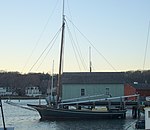Mystic, Connecticut

Mystic is a village and census-designated place (CDP) in Groton and Stonington, Connecticut. Mystic was a significant Connecticut seaport with more than 600 ships built over 135 years starting in 1784. Mystic Seaport, located in the village, is the largest maritime museum in the United States and has preserved a number of sailing ships, such as the whaling ship Charles W. Morgan. The village is located on the Mystic River which flows into Fishers Island Sound. The Mystic River Bascule Bridge crosses the river in the center of the village. The name "Mystic" is derived from the Pequot term "missi-tuk" describing a large river whose waters are driven into waves by tides or wind. The population was 4,348 at the 2020 census.
Excerpt from the Wikipedia article Mystic, Connecticut (License: CC BY-SA 3.0, Authors, Images).Mystic, Connecticut
Willow Street,
Geographical coordinates (GPS) Address Nearby Places Show on map
Geographical coordinates (GPS)
| Latitude | Longitude |
|---|---|
| N 41.354166666667 ° | E -71.966388888889 ° |
Address
Willow Street 29
06378
United States
Open on Google Maps









